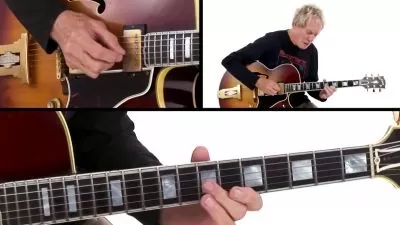Shortcut to Guitar: Beginner Guitar Course
Peter Holland
9:26:50
Description
Easy guitar learning concept built around one basic chord shape and one key and utilizing the "thumb strum"
What You'll Learn?
- To know how the guitar works and to get it ready for playing
- To understand the basics of music theory
- To know and be able to use all the chords in a key
- To be able to construct simple melodies around chord progressions
Who is this for?
What You Need to Know?
More details
DescriptionBy separating the different disciplines needed to play the guitar the journey to guitar playing enjoyment is made easy.
Simplifying the learning process helps beginners get over the usual stumbling blocks with ease.
The course also gives the student a solid foundation in musical understanding.
The lessons show how using our simple chord shapes chord progressions (and therefore, simple songs) are constructed, with special emphasis placed on a typical "blues" progression, and how to embellish those simple chords to add melody to the rhythm (the students own natural rhythm at first and then later counted out rhythm) and the harmony from the chords.
The lessons encourage the use of the "thumb strum" a simple alternative to playing strum/rhythm patterns with a pick/plectrum, which is difficult for beginners. But don't worry, the "thumb strum" leads to many other types of guitar playing such as fingerstyle, percussive, flamenco, folk, and it won't hinder you if you want to pick up a plectrum to play later on!
These "shortcuts" which simplify the physical side of playing the guitar enable the learner to develop a better understanding of how music is constructed on a guitar and how music is constructed in general, giving a great foundation for future learning, a foundation that only enhances the student's enjoyment of playing the guitar and sense of achievement.
Try it and see for yourself
The course also covers all the basics of the guitar, such as knowing the anatomy of the instrument as well as how it works. How to tune up the guitar using an electronic tuner or phone app and by ear. There is also instruction on how to change a broken string and how to restring all the six strings of the guitar.
Who this course is for:
- Complete beginner guitarists who want to understand music as well as play it.
- Budding songwriters looking for a shortcut into using guitar as a songwriting tool.
By separating the different disciplines needed to play the guitar the journey to guitar playing enjoyment is made easy.
Simplifying the learning process helps beginners get over the usual stumbling blocks with ease.
The course also gives the student a solid foundation in musical understanding.
The lessons show how using our simple chord shapes chord progressions (and therefore, simple songs) are constructed, with special emphasis placed on a typical "blues" progression, and how to embellish those simple chords to add melody to the rhythm (the students own natural rhythm at first and then later counted out rhythm) and the harmony from the chords.
The lessons encourage the use of the "thumb strum" a simple alternative to playing strum/rhythm patterns with a pick/plectrum, which is difficult for beginners. But don't worry, the "thumb strum" leads to many other types of guitar playing such as fingerstyle, percussive, flamenco, folk, and it won't hinder you if you want to pick up a plectrum to play later on!
These "shortcuts" which simplify the physical side of playing the guitar enable the learner to develop a better understanding of how music is constructed on a guitar and how music is constructed in general, giving a great foundation for future learning, a foundation that only enhances the student's enjoyment of playing the guitar and sense of achievement.
Try it and see for yourself
The course also covers all the basics of the guitar, such as knowing the anatomy of the instrument as well as how it works. How to tune up the guitar using an electronic tuner or phone app and by ear. There is also instruction on how to change a broken string and how to restring all the six strings of the guitar.
Who this course is for:
- Complete beginner guitarists who want to understand music as well as play it.
- Budding songwriters looking for a shortcut into using guitar as a songwriting tool.
User Reviews
Rating
Peter Holland
Instructor's Courses
Udemy
View courses Udemy- language english
- Training sessions 85
- duration 9:26:50
- Release Date 2024/04/13








